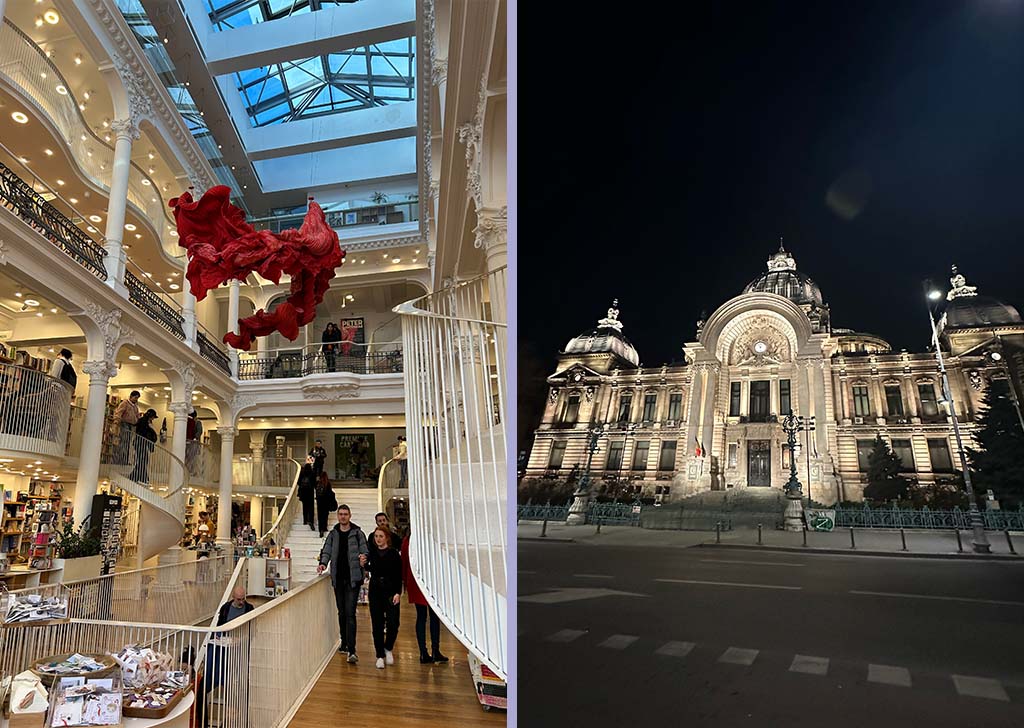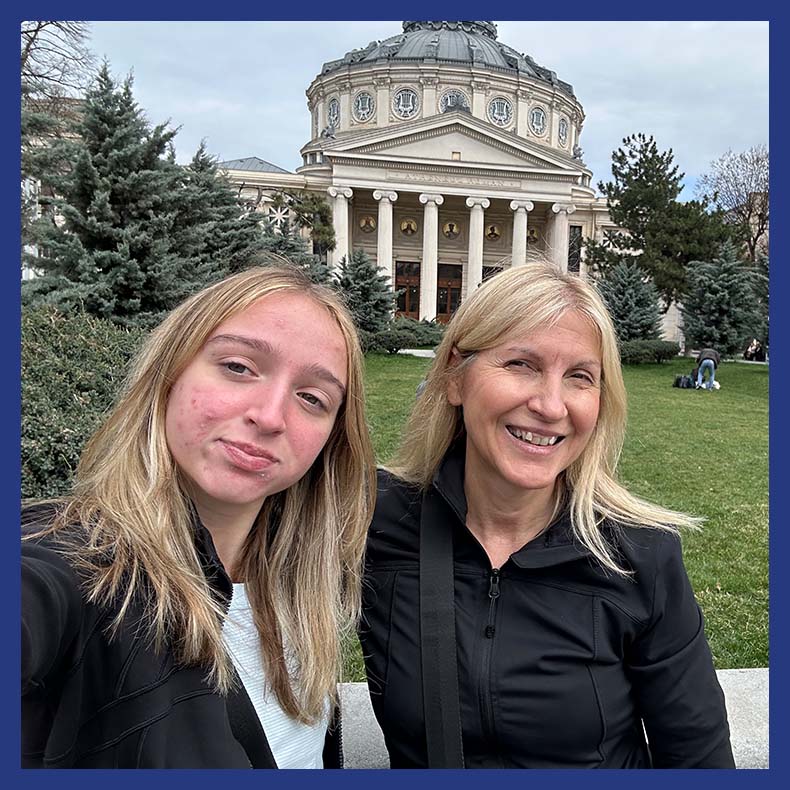BY CRIS DUSCHEK
Cris, a native of Romania, has written a travel article on Book Cottages showcasing the magic of Bucharest’s resurgence as ‘The Little Paris’
I had researched it for months, but the moment my daughter and I stepped into The Marmorosch Hotel in Bucharest’s Old Town – up the marble steps into a dizzying vaulted space glistening at every corner – I knew I had found the perfect starting point for our sojourn to my native city.
Much was at stake here.
I was traveling to Romania from America with my tween daughter, hoping to impress upon her to take pride in her heritage… and hopefully accompany me on future visits. I worried I had set the expectations too high. My build-up for the trip had been mighty.
Yet, moments after stepping off the gilded elevator into the opulent lobby, Allie declared she wanted to move to Bucharest! Enthused by her energy, the hotel staff proceeded to spoil my daughter with gifts, toys, and even lend a resident fish, called Bob, for the duration of our impeccable stay in town.
Some 35 years after the sudden fall of the previous despotic regime, Bucharest’s resplendent beauty is finally being restored. Known in between the two World Wars as Little Paris, or the Paris of the East, because of its elegant architecture, Bucharest is fast shaking off its communist past and restoring interbellum gems to their former glory.
The Belle Epoque Marmorosch Hotel, designed in neo-Romanian style with Gothic and Byzantine influences, and located in the former Marmorosch-Blank 1920s palace, is a prime example of the transformation. The bank was once Romania’s most powerful, having financed the country’s main railway and helped advance the development of manufacturing and petroleum industries during a flourishing period for the nation as a constitutional monarchy. Like the country, it met its demise soon after the communist invasion, with the abdication of King Michael in 1947.
Thanks to a significant investment from a Lithuanian group, the hotel opened in August 2021 as a five-star Marriott Autograph, a true boon to Bonvoy card holders.
Table Of Contents
Bucharest Bottoms Out
Even the most adventurous of travelers have reserved a special place for Eastern Europe, and it hasn’t always been kind. The stain of communism descended on this corner of the Old Continent after the Second World War. Moscow and its followers ruled for four decades with an iron fist, to the detriment of practically every aspect of life in the region.
Some say that Romania, which developed its own tyrannical rule, suffered the most, though it carried its pain with a great deal of grace.
Following a trip through the Iron Curtain, famed travel writer V.S. Pritchett noted how much the “blight” that had spread from Soviet Russia had affected the continent, but of Romania, he noted, “Bucharest is out to be a city of talk and pleasure.”
The Romance-language native of this land once occupied by Romans are decidedly Latin in manner. Some historians even believe that the ancient language here precluded Latin, as Vulgar Latin.

Bucharest Bounces Back
My daughter and I arrived late on a Saturday evening, dropped off our luggage in a suite worthy of Count Rostov at the Metropole (Amor Towles fans would get the reference from “A Gentleman in Moscow”), and dashed outside to take in this happy city. The location of the Marmorosch is ideal, steps away from Bucharest’s most famous and aristocratic avenue, Calea Victoriei, renamed Victory Road as a result of its War of Independence against the Ottomans in 1878.
Close to midnight, bars and restaurants with outdoor terraces were ringing with cheer and laughter on both sides of this elegant street that has always been a magnet for residents and tourists.
On each side of the street, palatial historic buildings like the Palace of the Deposits and Consignments (CEC to Romanians) and Museum of Art Collections light up the night. They are not monuments of solitude. These majestic buildings are surrounded by lovely boutiques, cafes, and terraces with revelers reminiscent of the streets in another Latin favorite of mine, Barcelona.
V.S. Pritchett made a note of Calea Victoriei, “once the Rue de la Paix of Bucharest,” admiring how, “the shop windows are dressed with a good deal of art and are more attractive to look at than the windows of Prague.”
If you’re looking to discover a stylish gem, for a weekend or more, use Calea Victoriei, and The Marmorosch, as your North Star. I know my native city quite well and for inspiration, I always roam around the Old Town and Calea Victoriei on foot.
All of the main sites are easily attainable by foot, and just in case you want to venture elsewhere, Ubers are plentiful anyway.
Bucharest Dining
All the walking, on top of the pastry and sweet delights we saw on every corner, gave us a perpetual appetite. We gave in to practically every culinary temptation.
At night after dinner, high on energy, Allie and I walked through Old Town past midnight, taking back to our room a large order of French crepes from an adorable food truck with a long line of customers. Every morning, we indulged in a delectable full-buffet breakfast at the hotel that would please even the pickiest of eaters. Allie is one of those, yet she would be the first to show up, excited for what was being offered.
The Marmarosch is generous with everything, including its fresh food – delicious cooked eggs, hash browns, bacon, fresh fruit, cheeses, platters of smoked salmon, homemade cakes and donuts. There are always several bottles of champagne on ice to make mimosas or simply celebrate being in this most fabulous city.
A note about the French-inspired pastries – they are everywhere in the city, whether sold as street food sweet or savory (flaky hot pockets with Feta or other types of salty cheese, apple or cherry strudels) – and they are most always under $1 each. The 1800s was the French century, and like elsewhere in Europe, Romanian upper classes visited Paris for inspiration, bringing back Parisian flair as Bucharest was refashioning itself, by the early 20th century, as a trendy metropolis. Patisseries (cofetării în Romanian) took hold. They survived communism in spite of food shortages, the one holdout of Romanian pride.
One of the most famous patisseries is Casa Capșa, on Calea Victoriei, two blocks from The Marmorosch. Founded in 1852 by two brothers, it soon moved to its current location, where it became an international sensation with its sensational chocolate, ganache, and bonbon confectionery. It opened a restaurant and hotel on the premises and became the supplier for the house of Prince Milan Orbenovic of Serbia and Prince Ferdinand of Bulgaria.
One of its greatest creations is still sold there, the joffre, the dessert of my dreams and of my childhood. This heavenly chocolate buttermilk layer cake filled with chocolate ganache originated in a cylindrical shape reminiscent of French military caps.
By the 1920s Capsa held court as the place to be for writers and aristocrats. At the invitation of King Ferdinand and Queen Marie of Romania, the French Marshal Joseph Jacques Cesaire Joffre arrived in Bucharest. Capsa’s master confectioner, educated in Paris, created the “joffre” in honor of the Marshal. Since the Frenchman suffered from diabetes, the cake had less sugar.
This dessert is addicting and manageable at little over two inches tall. It’s comme it faut, as the French would say. It is pricier, about $5 a piece, but keep in mind that you’re savoring the best of Romanian history with each morsel.

Walking through Bucharest
Walking on Calea Victoriei is always the thing to do, especially after a rich dessert. From April 6th until October 13th, during every weekend, a portion of Calea Victoriei is car free from 10 AM to 10 PM as part of the “Open Streets” projects. Pedestrians are entertained with a suite of artistic performances, live musical concerts, dance shows and sports activities as part of this huge festival, now in its second year.
Nearby to Capsa is Odeon Square and my favorite Bucharest Theater (and one of the oldest), Odeon Theater. Right there is another Belle Epoque luxury hotel, Grand Hotel Continental, a boutique property with over 200 years of history. Once known as Grand Hotel Broft, it was built in a chic Parisian style and welcomed as a guest Prince Napoleon, Napoleon III’s cousin, who was on a diplomatic visit to Charles I of Hohenzollern.
Prices vary, but the date that I checked, rates started at about $130 for a twin room and ran to $250 for a Senior Suite Double with Breakfast included. Compare that to luxury hotels in Paris or the States and you will wonder at this affordable luxury.
For the same date, The Marmorosch rates started at around $168 for a Silver twin room, to $446 for a Heritage, Large King or the ultimate 1,259-square-foot 1 bedroom Suite, at $1,530
Across the way is another piece of Bucharest history, Kretzulescu Church, commissioned almost exactly 300 years ago by a wealthy nobleman of that name. The proud brick church has withstood earthquakes and communism, and was once slated for demolition by the former dictatorial regime. It’s a survivor and stands tall at one of the corners of Revolution Square – named after the 1989 Revolution which toppled the dictator Nicolae Ceausescu and his wife – next to the former Royal Palace, now the National Museum of Art of Romania.
Steps away is another cultural gem, the Romanian Athenaeum and the “George Enescu Philharmonic.” Built in 1888 by the French architect Albert Galleron, this neoclassical concert hall is one of Bucharest’s most famous landmarks – tickets to concerts are not easy to find (Bucharest residents are cultural fiends) – but for a few dollars you can visit the hall on certain days. The breathtaking interior housing 800 seats is worth your time. The Big Hall centerpiece is a large fresco containing scenes from the most important moments of Romanian history up to 1919.
Next door is another famous landmark, the Athénée Palace, now a Hilton Hotel. Built 110 years ago at the height of Belle Epoque, the hotel became famous between the two World Wars as a refuge for wealthy and influential personages escaping Hitler. Its English Bar was a hotbed of spies and intrigue, and the place where foreign correspondents got their scoop.
Newsweek reporter R.G. Waldeck made the hotel the center of her 1942 book, “Athénée Palace, Hitler’s ‘New Order comes to Romania.”
In “Balkan Trilogy,” Olivia Manning centers much of the action inside the darkly-paneled smoky bar which she calls “the center of information.”
To this day, the hotel is popular with expats and spies – according to some. A classic twin room starts at around $171 and goes up to $410 for a 1-bedroom suite and beyond.
Bucharest Museums
Bucharest residents take great pride in their museums, and if that’s your kind of affordable luxury, you are in luck everywhere along the Calea Victoriei or nearby in Old Town. Depending on how much time you have, The National Museum of Art, located in the former Royal Palace, will delight your cultural expectations. Besides Old Masters works by El Greco, Tintoretto, Jan van Eyck, Jan Brueghel the Elder, Peter Paul Rubens, and Rembrandt, or Impressionists Claude Monet and Alfred Sisley, it features works by famous Romanian artists and sculptors including by Constantin Brâncuși.
In case we forget, the father of modern sculpture was born in Romania.
Notable, too, is the Medieval art collection, which now features works salvaged from monasteries destroyed during the Ceaușescu era.
I am partial to the Museum of National History, a couple of blocks from The Marmarosh in the other direction on Calea Victoriei. Another Neoclassical Palace built at the end of the 19th century as the Postal Services Palace, the 86,000-square-feet museum holds in its permanent collections valuable artifacts attesting to the ancient history of this land.
A must see every time I visit is “The Pietroasele Treasure” found in an area of Romania called Pietroasele, Buzău, in 1837. It is a late fourth-century Gothic treasure including some twenty-two objects of gold. Only twelve have survived and are displayed here: a large eagle-headed fibula and three smaller ones encrusted with semi-precious stones; a patera, or round sacrificial dish, modeled with Orphic figures surrounding a seated three-dimensional goddess in the center; a twelve-sided cup, a ring with a Gothic runic inscription, a large tray, two other necklaces and a pitcher.
The treasure was shipped to Moscow in December 1916 under the guise of “safekeeping” as German armies advanced through Romania in World War I. It was only partially returned in 1956. It is estimated that close to $16 billion of Romanian artifacts are still somewhere in Moscow.
Old town, around the corner from this museum, offers its own treasures (Bucharest has around 60 museums), like the cultural center ARCUB, located in a renovated 19th century inn.
Nearby is The Little Paris Museum, dedicated to recreating the French influence on the city in the 19th century. It is said that the terms Little Paris may have been coined by Balkan travelers who were amazed by the rapid Europeanization of Bucharest during that period. The museum recreates bourgeois Bucharest in a way only my grandmother could do, as she regaled me with stories of balls and the pool mansion my grandfather built for her after a French architect’s plan, only to have the Soviets take it over for themselves following the Second World War.
Speaking of communism and its destruction, I recommend making time for The Museum of Communism, also in Old Town. Opened in July 2023, it’s a boutique museum depicting life during that stern period and staffed by guides who put the era in perspective without the taint of nostalgia to “acknowledge and accept the past as it was,” as my guide articulated.

Bucharest Bookstores
One special mention for a temple to culture in Bucharest must be made: bookstores. Maybe because we were deprived by other distractions during communist rule, or maybe because we have always looked towards the West as part of our Francophile history, Romanians have always loved books. Bookstores and second-hand sellers have been a staple of the city for as long as I remember.
Following the fall of the Iron Curtain, entrepreneurs founded a new concept in books: Cărturești, named after a play on the Latin word that means books: carte. This online and physical bookseller has become a national obsession with over 50 bookstores in the country, most in Bucharest. As an immersive experience, it offers “an extensive collection of books, music, and art films, Cărturești extends a warm welcome with fragrant teas, ambient music, captivating book launches, and exhibitions featuring renowned artists.”
The chain recently opened its most stunning space to date, Cărturești Carusel, in Old Town, inside a 19th century bank building that had been confiscated by communists. With its Classical columns and spiraling staircases, it has been transformed into a magical temple of books and one of the most beautiful bookstores in the world with six floors and over 10,000 books to choose from.
More Meals in Bucharest
With all the walking and museum visits, you’ll work up an appetite and rest assured you have options for any budget. You can choose from mostly informal cafes, brasseries, English-style pubs, or restaurants serving everything from traditional Romanian, to Italian, French, Greek and Vietnamese.
On this visit, I stayed close to The Marmorosch for our meals, many at the hotel’s restaurant, Blank. I especially enjoyed the Char Siu Pork Belly or Prawn & Chorizo Pasta (all under $30). I missed out on its swanky speakeasy inside the bank vault, The Vault Bar, but next time I’m in town, I am ordering the Frenchie, made with Ron de Jeremy rum, Saint Germain and Cointreau liqueurs, and Prosecco ($15). Another cocktail spot, trendy with everyone I know, is Casa Mița Biciclista, another refashioned historic building turned into a temple of creation over three floors – homemade croissants, books, exhibits, performances, and innovative cocktails.
My friends treated me to the fashionable gastropub Linea/Closer to the Moon, with a breathtaking roof-top view of Old Town and Bucharest. I found the appetizer spreads out of this world: cream cheese with bacon, basil hummus and cauliflower with feta cheese ($8). My finicky daughter enjoyed her hamburger and fries.
One day, my tastes ran to traditional Romanian food, and for that I always visit La Mama (my favorite of the three centrally located restaurants by the same name is close to the Atheneum). Here, you’ll always find the best affordable homemade cuisine from stuffed cabbage to eggplant salad – the best version of Babaganoush you’ll ever taste – and incredible sour soups, chicken schnitzel. and fresh salads. My party of three shared a meal and a bottle of Romanian red wine and were out the door for under $60 with tip.
To enjoy Romanian food in high style, make a reservation at the Caru’ Cu Bere (the beer wagon) in Old Town. This is the most famous, scenic, and touristy Romanian restaurant in Bucharest. Opened in 1879 as a Bavarian brewery, the majestic Neo-Gothic building is magically Old World on the inside and out. Carved wood panels, paintings, high ceilings, stained-glass windows and tile mosaics throughout.
My last night in Bucharest I splurged for all the delights I couldn’t get back home in Romania except at my mom’s house: sour tripe soup served with chili peppers, an assortment of eggplant salad, and zacusca (smoky vegetable stew), Romanian mititei (grilled minced beef, lamb and pork rolls). I cheered our visit with a glass of Fetească Neagră, Romania’s ancient brand of deep red wine, and we shared a slice of chocolate “Childhood Cake” with ice cream and berries.
When the meal ended, my daughter and I looked at each other and sighed. We wouldn’t be sorry if our flight back to the US got canceled. Bucharest is home.





